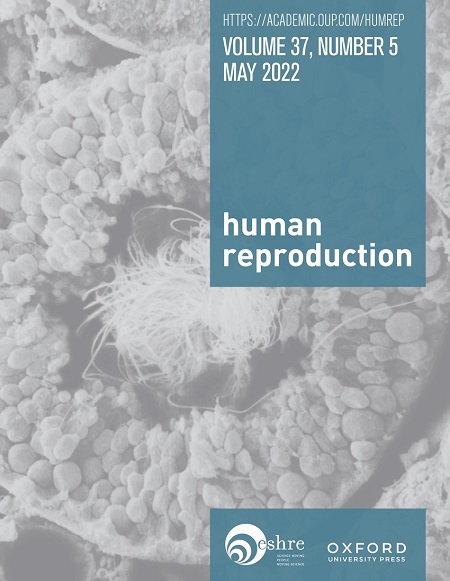Estradiol and progesterone levels in early pregnancy after modified natural, programmed, and gonadotrophin-stimulated frozen embryo transfer cycles: a randomized controlled trial
IF 6
1区 医学
Q1 OBSTETRICS & GYNECOLOGY
引用次数: 0
Abstract
STUDY QUESTION Are serum estradiol and progesterone levels higher in women treated with programmed cycle (PC) FET compared to women treated with a gonadotrophin-stimulated (gSC) FET or a modified natural cycle (mNC) FET during early pregnancy? SUMMARY ANSWER Estradiol and progesterone levels are higher on the day of embryo transfer in women treated with PC compared to those treated with a mNC or gSC. WHAT IS KNOWN ALREADY Various FET treatment regimens may affect the maternal hormone balance very differently in early pregnancy. Recent studies show that a PC is associated with increased risk of hypertensive pregnancy disorders, high birth weight, and postpartum hemorrhages. The underlying mechanism is not known but differences in hormone levels could play a role. STUDY DESIGN, SIZE, DURATION This was a parallel open-label randomized controlled drug trial conducted from April 2021 until December 2024. The target sample size was 100 cycles in each treatment arm for a power of 80%. A total of 305 cycles were included and 257 were included in the per-protocol analysis. Ovulatory women were randomized to either a PC or a mNC. Anovulatory women were randomized to a PC or a gSC. Blood samples were obtained at seven consecutive time points from the start of the cycle until gestational age (GA) 9 + 6 weeks. Obstetric and neonatal follow-up was completed through the patients’ digital medical records. Primary outcomes were differences in serum estradiol and progesterone between patient groups and treatment regimens. Secondary outcomes were to compare the type of cycle with reproductive, obstetric, and neonatal outcomes between groups. PARTICIPANTS/MATERIALS, SETTING, METHODS The trial was conducted in the Fertility Clinic at Herlev University Hospital, Denmark. Participants were women aged 18–40 years with BMI ≤35 kg/m2. Only women using autologous frozen blastocysts were eligible and all women had a normal wet cervical wet smear within the last 3 years. MAIN RESULTS AND THE ROLE OF CHANCE For ovulatory women, estradiol and progesterone levels were higher in PCs on the day of embryo transfer day compared to mNCs (estradiol: 0.86 nmol/l vs 0.54 nmol/l, adjusted P < 0.001, progesterone: 68.5 nmol/l vs 40.3 nmol/l, adjusted P < 0.001), and progesterone levels were also higher in PCs at GA 8 + 0 (87.5 nmol/l vs 61.2 nmol/l, adjusted P = 0.02). For anovulatory women, the same trend was observed when comparing PCs to gSCs. Serum estradiol was significantly higher on the day of embryo transfer day (0.96 nmol/l vs 0.54 nmol/l, adjusted P < 0.01), though no significant differences in progesterone were found. We found no differences in pregnancy rates, live birth rates, pregnancy loss rates, or cancelation rates. Ovulatory women treated with PCs had significantly larger children with an estimated treatment difference of 292 grams (P < 0.01) compared to those treated with mNCs. Furthermore, we observed a higher risk of postpartum hemorrhages in PCs compared to mNCs (22/40 (55%) vs 10/40 (25%), P = 0.01). LIMITATIONS, REASONS FOR CAUTION The target sample size of 100 cycles was not achieved in either of the anovulatory arms. WIDER IMPLICATIONS OF THE FINDINGS This is the first randomized trial to investigate differences in maternal sex hormones between FET regimens. Although higher levels of estradiol and progesterone were demonstrated in PCs compared to mNCs and gSCs on the day of embryo transfer day, the significance of these findings is currently unclear. Further research is needed to verify these results and to examine possible effects on pregnancy and fetal development. STUDY FUNDING/COMPETING INTEREST(S) The study has received grants from Gedeon Richter Nordics AB (DK-2019-04, DK-2022-03, DK-2023-08, DK-2023-06, DK-2024-08) and a grant from the Gangsted-Rasmussen Foundation (ref. A39784). The study has also received a grant from the local research board at Herlev University Hospital. The funders of the trial had no role in the design and planning phase, data analysis, or interpretation of the results. Ongoing analyses of biobank samples have been funded by Merck A/S. M.S.S., H.U., and M.L.B. have no conflicts of interest. N.F.M. has, outside this work, received funding for congress registration from Gedeon Richter Nordics AB. P.F.S. has, outside this work, received grants from Merck A/S, Gedeon Richter Nordics AB, and Ferring Pharmaceuticals A/S. Outside this work, B.N. has received grants from Merck A/S, Gedeon Richter Nordics AB, and Ferring Pharmaceuticals A/S, personal fees from Ferring Pharmaceuticals A/S, travel support from Gedeon Richter Nordics AB, and participated in a data safety monitoring or advisory board for Ferring Pharmaceuticals A/S. TRIAL REGISTRATION NUMBER 2020-001218-39 in EudraCT. TRIAL REGISTRATION DATE 17 November 2020. DATE OF FIRST PATIENT’S ENROLMENT 20 April 2021.经改良的自然、程序化和促性腺激素刺激的冷冻胚胎移植周期后早期妊娠的雌二醇和孕酮水平:一项随机对照试验
研究问题:在妊娠早期,与接受促性腺激素刺激(gSC) FET或改良自然周期(mNC) FET治疗的女性相比,接受程序化周期(PC) FET治疗的女性血清雌二醇和黄体酮水平是否更高?在胚胎移植当天,接受PC治疗的女性的雌二醇和孕酮水平高于接受mNC或gSC治疗的女性。妊娠早期不同的FET治疗方案对母体激素平衡的影响差异很大。最近的研究表明,PC与高血压妊娠障碍、高出生体重和产后出血的风险增加有关。潜在的机制尚不清楚,但激素水平的差异可能起作用。研究设计、规模、持续时间这是一项平行开放标签随机对照药物试验,于2021年4月至2024年12月进行。目标样本量为每个治疗组100个周期,功率为80%。每协议分析共包括305个周期,257个周期。排卵期妇女被随机分配到PC组或mNC组。无排卵妇女被随机分配到PC组或gSC组。从周期开始到胎龄(GA) 9 + 6周,在连续7个时间点采集血样。通过患者的数字医疗记录完成产科和新生儿随访。主要结果是患者组和治疗方案之间血清雌二醇和黄体酮的差异。次要结局是比较两组之间的周期类型与生殖、产科和新生儿结局。受试者/材料、环境、方法本试验在丹麦Herlev大学医院生育诊所进行。参与者为年龄在18-40岁,BMI≤35 kg/m2的女性。只有使用自体冷冻囊胚的妇女才有资格,所有妇女在过去3年内都进行了正常的宫颈湿涂片检查。排卵妇女在胚胎移植当天的雌二醇和黄体酮水平在PCs中高于mNCs(雌二醇:0.86 nmol/l vs 0.54 nmol/l,调整P &;lt;0.001,黄体酮:68.5 nmol/l vs 40.3 nmol/l,调整P &;lt;在GA 8 + 0时,黄体酮水平也更高(87.5 nmol/l vs 61.2 nmol/l,调整P = 0.02)。对于不排卵的女性,当比较pc和gSCs时,也观察到同样的趋势。血清雌二醇在胚胎移植当天显著升高(0.96 nmol/l vs 0.54 nmol/l,调整P &;lt;0.01),但黄体酮含量无显著差异。我们发现妊娠率、活产率、流产率或取消率没有差异。接受PCs治疗的排卵期妇女的孩子明显更大,估计治疗差异为292克(P <;0.01)。此外,我们观察到与跨国公司相比,pc的产后出血风险更高(22/40 (55%)vs 10/40 (25%), P = 0.01)。两个无排卵组均未达到100周期的目标样本量。研究结果的更广泛意义这是第一个调查FET方案之间母体性激素差异的随机试验。尽管在胚胎移植当天,与跨国公司和gSCs相比,pc中的雌二醇和黄体酮水平较高,但这些发现的意义目前尚不清楚。需要进一步的研究来验证这些结果,并检查对妊娠和胎儿发育的可能影响。本研究已获得Gedeon Richter Nordics AB (DK-2019-04, DK-2022-03, DK-2023-08, DK-2023-06, DK-2024-08)和Gangsted-Rasmussen基金会(ref. A39784)的资助。这项研究还得到了当地赫列夫大学医院研究委员会的资助。试验的资助者在设计和计划阶段、数据分析或结果解释中没有任何作用。正在进行的生物样本分析由默克公司资助。m.s.s., h.u.和M.L.B.没有利益冲突。在这项工作之外,N.F.M.还从Gedeon Richter Nordics公司获得了国会注册的资金。P.F.S.在这项工作之外,还从默克公司、Gedeon Richter Nordics公司和Ferring Pharmaceuticals公司获得了资助。除此之外,B.N.还获得了Merck A/S、Gedeon Richter Nordics AB和Ferring Pharmaceuticals A/S的资助,Ferring Pharmaceuticals A/S的个人费用,Gedeon Richter Nordics AB的差旅支持,并参加了Ferring Pharmaceuticals A/S的数据安全监测或咨询委员会。试验注册号2020-001218-39在草案中。试验注册日期为2020年11月17日。第一位患者入组日期为2021年4月20日。
本文章由计算机程序翻译,如有差异,请以英文原文为准。
求助全文
约1分钟内获得全文
求助全文
来源期刊

Human reproduction
医学-妇产科学
CiteScore
10.90
自引率
6.60%
发文量
1369
审稿时长
1 months
期刊介绍:
Human Reproduction features full-length, peer-reviewed papers reporting original research, concise clinical case reports, as well as opinions and debates on topical issues.
Papers published cover the clinical science and medical aspects of reproductive physiology, pathology and endocrinology; including andrology, gonad function, gametogenesis, fertilization, embryo development, implantation, early pregnancy, genetics, genetic diagnosis, oncology, infectious disease, surgery, contraception, infertility treatment, psychology, ethics and social issues.
 求助内容:
求助内容: 应助结果提醒方式:
应助结果提醒方式:


